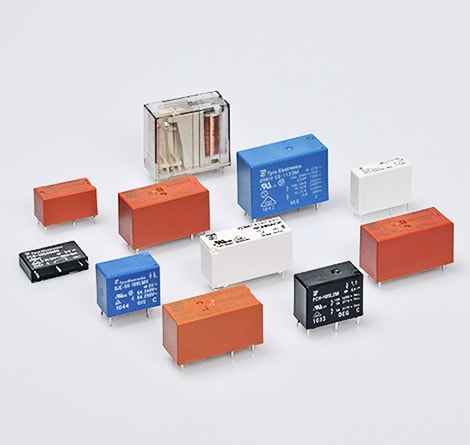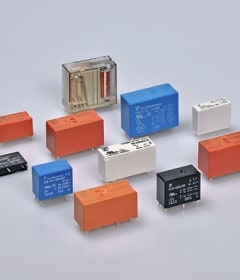
Seamless power flow with our electromechanical power relays
Power relays open or close a circuit by using an electromagnetic coil for seamless power flow. These cost-efficient relays are manufactured with an armature, spring, and one or several contacts. If the relay is meant to be normally open (NO), when power is applied the electromagnet attracts the armature. It is pulled in the coil’s direction until it reaches a contact, resulting in closing the circuit. Similarly, if the relay is meant to be normally closed (NC), the electromagnetic coil pulls the armature away from the contact, resulting in opening the circuit.
Our relays can be used anywhere in the intelligent building system — in elevators and escalators, control panels, motion control systems, lighting, building systems, and an array of safety-critical applications to mention just a few. In this Application Guide, you can find our relays products suitable for use in building equipment including HVAC, lighting and solar applications. Here you can find cost-effective, reliable solutions designed to withstand extreme shock, vibration, temperature, and altitude, from our recognized brands: AGASTAT, AXICOM, Potter and Brumfield, PRODUCTS UNLIMITED, SCHRACK, OEG as well as TE.
What is a Power Relay?
Power relays are categorized by mechanical features – miniature, PCB, industrial, and more. While miniature power relays are small this term does not always indicate absolute size, PCB power relays are designed to be mounted onto printed circuit boards (PCBs). Industrial relays are typically used in switching cabinets by control panel builders. Industrial relays are engineered to meet industry expectations such as Underwriters Laboratory (UL).
The basic design of electromechanical power relays is the same, regardless of whether it is a miniature PCB relay or an industrial power relay. Power relays have three subsystems: contact system, magnetic system, and mechanical components. The primary components in a power relay include – on the contact system, or secondary side – fixed contacts, moving contacts (moved by the magnetic system – the motor – to switch the load circuit), and contact springs (holding the contacts but flexible enough to all the contacts to move).
The magnetic system includes the coil (generates the necessary magnetic field to actuate the armature and contacts), the core, the yoke (establishes the magnetic circuit), the armature (the moving part that closes and opens the magnetic circuit and acts – via a comb or actuator – on the moving relay contacts), and the return spring (establishes the defined position of the magnetic and contact system in case the coil is not energized).
The mechanical components include the case, base, insulation (separates the primary circuit from the secondary side and provides required insulation), actuator (can translate motion of magnetic system to the moving contacts), pins or terminals (connects the contact system and the load), and mounting devices. Most power relays are monostable (non-latching) relays with a neutral coil system and only one stable position. These will stay in this non-energize state, without receiving power.
Incandescent lamps, inductive loads like motors and solenoids, capacitive loads like electronic ballasts and switching power supplies, etc. can exhibit very high initial surge currents upon energizing. This can be up to 10X the steady state current or more and is especially troublesome should the contact closure randomly occur near the peak of the voltage sine-wave. Welding of contacts due to such excessive surge current is often the result. Relays for such applications usually need to be oversized or specially designed to handle the high inrush current relative to the relatively modest steady state current. This usually results in extra control cost and increased space usage. The application notes looks at how synchronizing contact can make and break to the load voltage and current can yield marked improvement in performance when properly implemented.
Select Applications
Power Relays
Power relays are used in automotive, control, power, safety, and signal systems. In building systems, such as elevators and escalators, power PCB relays are designed for PCB mounting primarily in elevator control sub systems, door control, and illumination. In HVAC, power PCB relays are used in thermostats, electric boilers (to switch on heating time), general pumps and fan control to name a few. In lighting systems, inrush power relays are especially suitable for electronic ballast and LED lighting. Other applications include movement detectors, remote controls and bus system actuators.
Relays for Lighting
-
Lighting Relay Guide
Whether you are designing your lighting or outlet controller for 120v, 277, 347, or 480v, we have extensive capabilities in the design and manufacture of relays for the task. Learn more by downloading our lighting relay guide.
SCHRACK Slimline PCB Relay SNRII
TE Connectivity’s SNRII slim PCB relay is a compact 5 mm-wide solution designed for PCB mounting, available in vertical, flat pack, and DIN rail socket-compatible versions with reinforced coil terminals. Featuring a 6A single changeover (CO) contact, the SNRII serves as a direct replacement for the legacy SNR (V23092 Series), offering full compatibility with existing socket solutions. It delivers enhanced performance with improved vibration resistance and a longer mechanical and electrical lifecycle, making it ideal for space-constrained applications that demand reliability and durability.
Key Features
- Compact Design - 5 mm wide
- 1 pole 6A, 1 form C (CO)
- Low load 5V 1mA without gold contacts
- Ambient temperature up to 105 °C
- Sensitive coil 170 mW
- Lower PCF, more eco-friendly than SNR
SCHRACK SNR Slimline Relay Package
TE Connectivity (TE)’s SCHRACK SNR Slimline Relay Package consists of din rail sockets and relays, with a module width offering in6.2 mm, 1 CO with 6 A rated current, ideal for increased package density on the din rail.
Key Features
- Supports low load handling.
- Provides high density on DIN rail.
- Different coil voltage options and change-over contacts are available. The gold-plated version is available.
- Quickly adapts to the application
Miniature Relay PT01
TE Connectivity (TE)’s ECP40B series high-voltage DC contractor Introduction - The Miniature Relay PT01 is a general-purpose panel plug-in relay designed for efficient circuit control. Engineered for flexibility, it can be mounted on a DIN rail using a socket or directly soldered onto a printed circuit board — making it ideal for a wide range of Industrial control and automation applications.
Key Features
- Small size ensuring space saving for customer control box
- Switching Voltage up to 1500VDC meeting system voltage requirementsHigh performance in electrical endurance
- Bi-directional contacts design ensuring safety ensured during charge and discharge
High Voltage DC Contactor ECP 40B Series
TE Connectivity (TE)’s ECP40B series high-voltage DC contractor is designed for control in high voltage environments like battery energy storage system, solar inverters, and EV charging applications. ECP40B series is designed and suited for pre-charge applications. It can be used in 1500 VDC voltage systems, and the enhanced insulation distance meets the requirement of UL60947-4-1 and IEC60947-4-1 standards. The contacts provided in this series allows bi-directional load and are hermetically sealed with ceramic sealing technology, making it safer and more reliable.
Key Features
- Panel plug-in relay
- AC and DC with various voltage levels available
- UL,CE, CQC certificated
- Integrated LED indicator
- Operating environment temperature is -40 to 70°C
Power PCB Relay T9F Series
TE Connectivity (TE) introduces the T9F series 32Amp miniature relays designed for generating control in the latest energy and power supply applications. The T9F series product line is a noteworthy and reliable solution for EV charging, power supply, solar inverters, and battery energy storage system applications. It has 32Amp current capability and is suitable for 105⁰C environments. More importantly, its size is significantly minimized to create space savings for the customer.
Key Features
- 1 pole 32A, 1 form A (NO) contact
- Ambient temperature up to 105⁰C at 32A
- Small size and footprint ensure space saving
- Compliant with AEC-Q200
The T9F series product line is a noteworthy and reliable solution for EV charging, power supply, solar inverters, and battery energy storage system applications.
SCHRACK SR4 Force Guided Relays
TE Connectivity (TE)’s SCHRACK SR4 is a compact and space efficient force guided relay for loads up to 8 A. The optimized ratio between 13 mm width and 16.5 mm height helps allow miniaturization for horizontally or vertically installed PCBs and modules. With its force guided contact set, the state of a contact can be monitored with a diagnostic coverage of 99% (IEC 61508-2) which makes the SR4 highly reliable to design safety circuits. The SR4 is produced both in Europe and China to optimally serve local customers.
Key Features
- 4 pole contact arrangement with either 3 NO (form A) + 1 NC (form B) contact set or
- 2 NO (form A) + 2 NC (form B) contact set with force-guided relays contacts according to IEC 61810-3 (formerly EN50205)
- Compact design and space-efficient
- Height of 16.5 mm fits well in 22.5 mm DIN rail housings
SCHRACK SR4 is a compact, space-efficient force-guided relay for loads up to 8 A.
High Voltage DC Contactor ECP 600B Series
The ECP600B series high-voltage DC contactor which is designed for control in high-voltage environments in battery energy storage systems, solar inverters, and EV charging applications. The special contact design enables it to endure bi-directional load and perform well under a 1500VDC voltage system with a long life and high reliability.
Benefits
High Voltage Contactor ECP 600B Series
- Hermetically sealed with ceramic technology ensuring high reliability
- Continuous carry current capability of 800A
- High performance in electrical endurance with Max. breaking capacity up to 1500VDC at 1000A
- Allows bi-directional load
- Dual coil design withholding 5.0W of power
- Equipped with auxiliary contact and smart monitoring for main contact status
- Complies with DC-1 utilization category in IEC60947-4
High Voltage DC Contactor ECK 150B, 200B and 250B Series
TE Connectivity (TE) introduces the ECK 150B, 200B & 250B high-voltage DC contactor series, designed for control in new energy applications. The ECK product line is an innovative and reliable solution for EV charging stations, solar inverters, battery energy storage systems, automated-guided vehicles (AGVs) & e-Forklifts and other high voltage applications. They allow bi-directional loads and are hermetically sealed with ceramic sealing technology making it safe and reliable. These contactors can be used in 1000VDC system applications.
Features
High Voltage DC Contactor ECK 150B, 200B and 250B Series
- Hermetically sealed with ceramic technology
- Switching voltage up to 1000VDC
- Bi-directional contacts
- Optional auxiliary contact
- Complies with DC-1 utilization category
Benefits
High Voltage DC Contactor ECK 150B, 200B and 250B Series
- Meets the system upgrade requirement
- High performance in electrical endurance making it suitable for high voltage applications.
- Allows for bi-directional load.
- Smart monitoring for main contact status
- CE approved, serving as a global solution for customer projects.
High Voltage DC Contactor ECK 50B and 100B Series
TE Connectivity (TE) introduces the ECK 50B/100B high-voltage DC contactor series which is designed for control in new energy applications. The ECK product line is an innovative and reliable solution for EV charging stations, solar inverters, battery energy storage systems, automated-guided vehicles (AGV), and e-forklifts. These contactors allow bi-directional loads and are hermetically sealed with ceramic sealing technology making them safe and reliable. They are also suitable for 1000VDC system applications.
Features
High Voltage DC Contactor ECK 50B and 100B Series
- Hermetically sealed with ceramic technology
- Switching voltage up to 1000VDC
- Bi-directional contacts
- Optional auxiliary contact
- Comply with the DC-1 utilization category
Benefits
High Voltage DC Contactor ECK 50B and 100B Series
- Meets the system upgrade requirement
- High performance in electrical endurance making it suitable for high voltage applications
- Allows bi-directional load
- Smart monitoring for main contact status
- CE approved, serving as a global solution for customer




